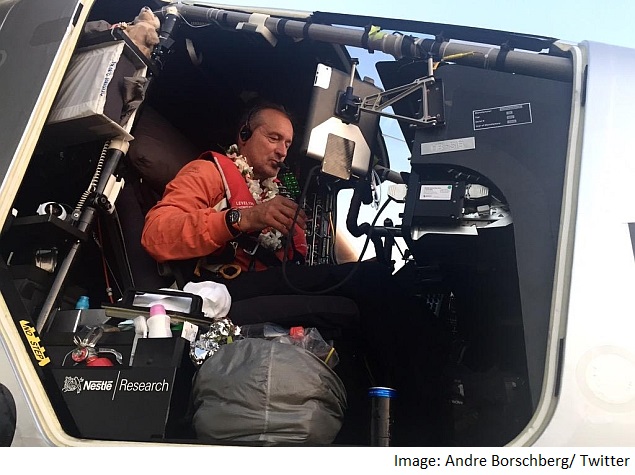- Home
- Science
- Science News
- Solar Impulse 2 Lands in Hawaii, Pilot Sets Non Stop Solo Flight Record
Solar Impulse 2 Lands in Hawaii, Pilot Sets Non-Stop Solo Flight Record

The Solar Impulse 2 aircraft completed a historic flight in its quest to circle the globe without consuming a drop of fuel, touching down gracefully in Hawaii on Friday after the most arduous leg of its journey.
The sun-powered plane, piloted by veteran Swiss aviator Andre Borschberg, took 118 hours -- about five days -- to make the voyage from Japan to Hawaii and landed shortly after dawn at Kalaeloa Airport on the main Hawaiian island of Oahu.
"Just landed in #Hawaii with @solarimpulse! For @bertrandpiccard and I, it's a dream coming true," Borschberg tweeted triumphantly after completing the most perilous part of the around-the-world odyssey.
Borschberg and Bertrand Piccard have been alternating the long solo flights and Japan to Hawaii - where it was Borschberg in sole control - was the eighth of 13 legs.
"Difficult to believe what I see: #Si2 in Hawaii! But I never had doubts that @andreborschberg could make it!" tag-team copilot Piccard wrote on Twitter.
"This flight to Hawaii is not only an aviation historic first, but also a historic first for energy and cleantechs."
The experimental plane landed a little after 4pm GMT (9:30pm IST), and Borschberg, all smiles, emerged a short time later from the cockpit, later adorning a traditional Hawaiian flower lei and holding a celebratory bottle of champagne.
Sunlight glimmered on the horizon as the Solar Impulse ground crew burst into cheers and applause upon completion of the groundbreaking flight.
The 4,000-mile leg (6,500 kilometers) from Nagoya, Japan to Hawaii was not only the world's longest solar-powered flight both in terms of flying time and distance, it also set the record for longest solo flight by time.
The whole trip from Japan to Hawaii took four days and 22 hours, with the Swiss aviator taking catnaps of only 20 minutes at a time to maintain control of the pioneering plane.
Borschberg easily beat the previous longest solo endurance flight, by Steve Fossett, who flew for 76 hours and 45 minutes in 2006 in the Virgin Atlantic GlobalFlyer.
Fellow pioneering aviator and Virgin Group founder Richard Branson tweeted his congratulations to Borschberg and his team.
"Congrats @SolarImpulse, beating @Virgin GlobalFlyer record non-stop solo flight without refuelling. Huge step forward," Branson wrote.
Yoga in the sky
The flight tested its exhausted pilot to the maximum, in what his team described as "difficult" conditions.
Traveling at altitudes of more than 9,000 meters (29,500 feet), Borschberg at times had to use oxygen tanks to breathe and experienced huge swings in temperature throughout.
Alone throughout the entire flight and utterly self-reliant in the unpressurized cockpit, Borschberg was equipped with a parachute and life raft, in case he needed to ditch in the Pacific.
Mission organizers described the journey as having taken "pilot and aircraft to the limits" of their endurance.
Borschberg, born in Zurich, is no stranger to adventure - 15 years ago, he narrowly escaped an avalanche, and then in 2013 he was involved in a helicopter crash that left him with minor injuries.
The pilot, who is also a yoga enthusiast, has worked as an army pilot and supervised the construction of the first Solar Impulse plane.
In 2010, for the first time in history, he flew 26 hours straight using only solar energy.
Borschberg didn't let the tiny cockpit of the Solar Impulse 2 plane stop him from practising yoga, transforming his tiny bench into a yoga mat and using specialized postures custom-tailored for him by his personal yogi.
"Yoga is a great support for this flight above the Pacific: it positively affects my mood and mindset," Borschberg tweeted Thursday with a photo of himself in a pose.
Next stop: Phoenix
The plane will now be flown across the United States and eventually, if all goes according to plan, land back in Abu Dhabi next March, where it started its journey earlier this year.
The next leg will be piloted by Piccard and will fly 2,920 miles from Hawaii to Phoenix.
Solar Impusle 2 has 17,000 solar cells and on-board rechargeable lithium batteries, allowing it to fly through the night.
Its wingspan is longer than that of a jumbo jet but it weighs only 2.3 tonnes -- about the same as a car.
Catch the latest from the Consumer Electronics Show on Gadgets 360, at our CES 2026 hub.
- Samsung Galaxy Unpacked 2025
- ChatGPT
- Redmi Note 14 Pro+
- iPhone 16
- Apple Vision Pro
- Oneplus 12
- OnePlus Nord CE 3 Lite 5G
- iPhone 13
- Xiaomi 14 Pro
- Oppo Find N3
- Tecno Spark Go (2023)
- Realme V30
- Best Phones Under 25000
- Samsung Galaxy S24 Series
- Cryptocurrency
- iQoo 12
- Samsung Galaxy S24 Ultra
- Giottus
- Samsung Galaxy Z Flip 5
- Apple 'Scary Fast'
- Housefull 5
- GoPro Hero 12 Black Review
- Invincible Season 2
- JioGlass
- HD Ready TV
- Laptop Under 50000
- Smartwatch Under 10000
- Latest Mobile Phones
- Compare Phones
- OPPO Reno 15 Pro Max
- Honor Win RT
- Honor Win
- Xiaomi 17 Ultra Leica Edition
- Xiaomi 17 Ultra
- Huawei Nova 15
- Huawei Nova 15 Pro
- Huawei Nova 15 Ultra
- Asus ProArt P16
- MacBook Pro 14-inch (M5, 2025)
- OPPO Pad Air 5
- Huawei MatePad 11.5 (2026)
- Xiaomi Watch 5
- Huawei Watch 10th Anniversary Edition
- Acerpure Nitro Z Series 100-inch QLED TV
- Samsung 43 Inch LED Ultra HD (4K) Smart TV (UA43UE81AFULXL)
- Asus ROG Ally
- Nintendo Switch Lite
- Haier 1.6 Ton 5 Star Inverter Split AC (HSU19G-MZAID5BN-INV)
- Haier 1.6 Ton 5 Star Inverter Split AC (HSU19G-MZAIM5BN-INV)












